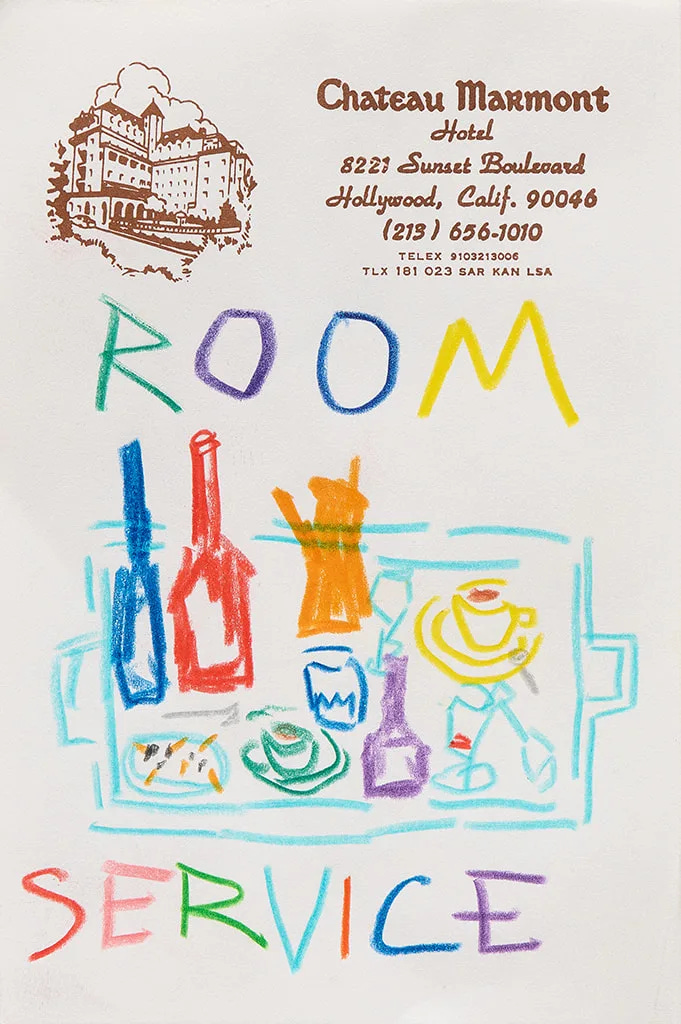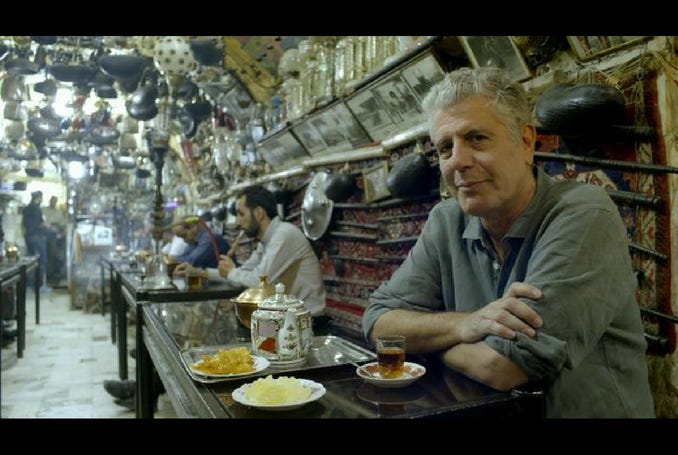Should kids be able to buy non-alcoholic beer, wine and mocktails?
Room Service, The expense of non-alcoholic drinks, Why there won't be another Anthony Bourdain, IDing for zero proof drinks? Coming together at the dinner table and more!
Hello readers,
Welcome back to another Drink Seco newsletter. Apologies for the long time between newsletters, as you might know Kate and I are still in Donostia this month. I’m hoping to make it up to you by pushing out a few newsletters out weekly to catch up a bit :)
We are both really excited to be on the East Coast for the holidays and see our friends and family. We have some warm adventures coming up before our next 3-month stay in Donostia. We’ll be celebrating a birthday of a family member in Costa Rica, spending some time in CDMX, exploring Tennessee / Kentucky / Montana / New Mexico (any suggestions??) and somehow hoping to continue to renovate the early 1900’s victorian back on the East Coast.
This week:
Why there won’t be another Anthony Bourdain
Should kids be able to buy non-alcoholic beer, wine and mocktails?
Why are non-alcoholic drinks so expensive?
Michael McGregor’s room service
Should kids be able to buy non-alcoholic beer, wine, and mocktails?
As it stands, there are no age restrictions for buying non-alcoholic drinks. But many shop owners and experts think there should be.
The Alcohol and Drug Foundation in Australia has recently called for zero-alcohol beverages to be subjected to the same regulations as full-strength products, arguing that they could normalize the consumption of alcohol or serve as a ‘gateway’ drink.
For parents with teenagers who, let’s face it, are probably going to try drinking before they’re 21, zero-proof drinks seem like a good option.
A recent article in NPR unpacks whether there should be. In the States, “39 states had no statewide policies, and the states that did were inconsistent – Michigan, for instance, restricted the sale of non-alcoholic beer to those 18 and up, but had no such policies for non-alcoholic wines or liquors.”
Daryl Collins, a zero-proof bottle shop owner in Baltimore has taken it upon himself to check the ID of everyone at his store. “When there’s no minimum age, can a nine-year old come into your store and buy a non-alcoholic Corona? For me, I don’t want that perception.”
“There’s no evidence so far that the boom in zero-proof beverages has led kids in the U.S. to drink alcohol, but Molly Bowdring (a clinical psychologist and researcher at the Stanford Prevention Research Center) looks to the recent example of e-cigarettes as a cautionary tale. “Tobacco use was really declining among more recent generations,” she says, “And then there’s this huge marketing push for vaping, and then it led to an uptick.”
Will the same thing happen with non-alcoholic beverages? I’m not sure, but I’m also not to sure if we should wait and find out.
Why are non-alcoholic drinks so expensive?
With the huge boom in zero-proof drinks, you might have found yourself asking this very question. Low No Drinker Magazine released a podcast episode unpacking the costs behind non-alcoholic drinks.
To summarise things for you, here are five big reasons behind the costs.
Preservatives- Alcohol is full of preservatives which means your drinks can last a long time. Non-alcoholic drinks don’t have this, which means they need other preservatives, which you guessed it, mean more $$. Add to this that the market of non-alcoholic drinkers are usually more health conscious, meaning synthetic preservatives don’t really cut it. Natural preservatives are a little trickier and more expensive.
Flavor- Alcohol has a lot of flavor! And usually, the flavor continues to develop with time. For zero-proof drinks, producers need to find alternative ways to bring in flavors. Often, through more ingredients, more technology, more experimenting.
Scale- Alcohol is the reaction to the yeast/sugars in whatever ingredients you’re using. To create zero-proof drinks, this process needs to be disrupted. Either through stopping fermentation during the process, or removing the alcohol at the end. Both processes are expensive.
Scale- Many producers (specifically smaller independent ones) can’t keep up with demand because they can’t scale and produce enough liquid at the right prices. To keep businesses afloat, businesses need to price up their drinks.
Marketing- Marketing is expensive! Most of the zero-proof drinks we know, are products under bigger brands and companies that already have brand recognition and customers. It’s a big challenge to get reach and customers for independent producers to even allow them to expand their business and thus lower their prices.
The upshot of all this? "If we want quality low no and light drinks to enjoy, then we're going to have to pay for them.”
Michael McGregor Room Service:
A little bit of an art break in today’s newsletter. Here are some drawings by Michael McGregor done on fancy hotel stationary from around the world which I thought was a little bit of fun.
Personally, room service in fancy hotels just makes me think of the scene of Kevin in Home Alone 2 (a movie you may have forgotten Donald Trump has a cameo in). Funnily enough, a few years ago the Plaza Hotel celebrated the 25th anniversary of the film with a special lodging package inspired by the film, complete with a huge ice cream sundae, upscale versions of Lunchables, Spaghettios, and Hot Pockets!
Why there won’t be another Anthony Bourdain:
In a past newsletter post ‘Finding Sweetness at the End of the World’ I shared an infamous Anthony Bourdain Quote urging everyone to “be open to a world where you may not understand or agree with the person next to you, but have a drink with them anyways.”
Once again I was delighted by Alicia Kennedy’s writing. Her latest piece begins to unpack “What Was ‘Parts Unknown’? and Why there won't be a "new" Anthony Bourdain.”
“Season two of the CNN show Parts Unknown, hosted by the late Anthony Bourdain, begins in Jerusalem. It was 2013, a year when peace talks between Palestine and Israel brokered by U.S. Secretary of State John Kerry fell apart. The show brings viewers to eastern Gaza, where a couple are cooking the Palestinian rice dish maklouba with eggplants, tomatoes, and their own fresh-killed chickens.”
Later, this episode would become a defining moment in the series and Bourdain’s career. He spoke about it on multiple occasions and won an award from the Muslim Public Affairs Council, in his acceptance speech he said “The world has visited many terrible things on the Palestinian people. None more terrible than robbing them of their basic humanity.”
The clip of this acceptance speech has resurfaced on the internet in the past few months given the ongoing genocide in Palestine.
As Kennedy writes “Using the mundane, everyday tool of food as a route toward complex political and cultural issues is his legacy; in doing so, he essentially invented the food-travel TV show genre. When he passed in 2018, a void was created that has not yet been filled.”
Bourdain came to represent ‘the everyday man’ with the unique ability to “code-switch between worlds both rough and refined that would propel his success.” As Doyle Green writes “Bourdain is equally at home slumming it in Third World poverty or carousing in posh destinations like San Sebastian.”
No one has quite filled the hole he left.
“When Tucci talks to Italian anarchists or Lakshmi holds the hand of a Trump voter in the borderlands of Texas, there’s a forced element to it, a sense that they’re performing a Bourdainian role rather than embodying themselves with any fullness or authenticity.”
He wasn’t without criticism or flaws, many have also critiqued the television whole genre of white men traveling to ‘exotic’ countries to interpret the ‘scary unknown’ and its imperialist themes. As Kennedy notes, the popular cultural landscape was quite different in 2005, and we lacked the ability to hear the real experiences of people living across the world (one thing we can thank social media for).
“While not a perfect form, the influence of Parts Unknown can be found in the fact that readers do want to journey to origins and they do want to know what life is like around the table where the dish is being served, not just how to make the dish themselves. It’s in the fact that a journalist like Azaiza shares not just what we might expect to see amid a people’s destruction, displacement, and genocide, but the moments of joy in sharing food. It’s in the popularity of others, too, who use social media to share the mundane moments of their eating, drinking, and travels as a way of illuminating their lives. Bourdain’s legacy may not be found in the genre of food television that he created, but in a way of using food as a lens that helps us see more of the world. There will no longer be one Everyman to guide viewers around the globe. Instead, there is the possibility of everyone, everywhere.”
That’s all for this week folks! Thanks for reading, see you next fortnight.
Carlie xx













